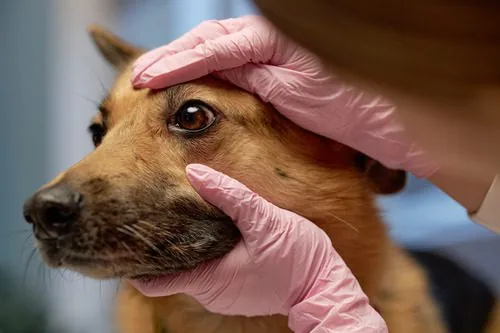Dog Eye Infection: Signs and What to Do
A dog eye infection can cause discomfort, changes in appearance, and even vision problems if left untreated. Eye infections in dogs happen when bacteria, viruses, fungi, or irritants cause inflammation in one or both eyes. You might notice redness, discharge, swelling, or your pet pawing at their eye. Because eye health is delicate, spotting a dog eye infection early and reaching out to your veterinarian at Schertz Animal Hospital is the best way to protect your pet’s comfort and vision.

What Causes a Dog Eye Infection?
A dog eye infection can have multiple causes, ranging from minor irritants to more serious medical conditions.
Common Causes of Dog Eye Infections
- Bacterial infections: These often develop after small scratches or injuries, when bacteria enter the eye.
- Viral infections: Viruses can cause swelling, redness, and watery discharge.
- Foreign bodies: Dust, grass seeds, or small particles can irritate the eye and lead to infection.
- Allergies: Dogs with environmental allergies may develop secondary infections from constant irritation and rubbing.
- Trauma: Scratches from play or rough surfaces may leave the eye vulnerable to bacteria.
When a dog eye infection is present, only your veterinarian can determine the underlying cause and recommend the proper treatment.
Signs of a Dog Eye Infection
Because your dog can’t tell you when their eye hurts, recognizing the signs of infection is key. A dog eye infection often looks different than mild irritation, and paying attention to these details can help you know when it’s time to schedule an appointment.
Symptoms Pet Owners May Notice
- Redness in or around the eye
- Yellow, green, or thick discharge
- Watery eyes or excessive tearing
- Swelling of the eyelids
- Cloudiness or visible film over the eye
- Squinting or keeping the eye closed
- Rubbing or pawing at the face
While some signs might seem minor at first, a dog eye infection can worsen quickly. Contacting your veterinarian at the first sign of trouble is always the safest choice.
How Veterinarians Diagnose a Dog Eye Infection
When you bring your pet into Schertz Animal Hospital, our team uses several methods to evaluate your dog’s eye health. Because many eye conditions look similar, accurate diagnosis is essential to confirm whether a dog eye infection is present or if something else is causing symptoms.
Diagnostic Steps
- Physical examination: A close look at the eye and surrounding tissues helps identify visible irritation, swelling, or discharge.
- Fluorescein staining: A special dye highlights scratches, ulcers, or damage to the cornea.
- Ophthalmoscope exam: This tool allows your veterinarian to look deeper into the structures of the eye.
- Culture and testing: Samples may be collected to determine whether bacteria, viruses, or fungi are causing the infection.
Through these steps, your veterinarian can create a clear plan to treat your dog’s eye and relieve their discomfort.
Why Prompt Veterinary Care Matters
A dog eye infection can impact your pet’s comfort and long-term vision. Delaying care increases the risk of complications, especially if the infection spreads or is linked to an injury.
Risks of Untreated Eye Infections
- Permanent scarring of the cornea
- Worsening pain and irritation
- Spread of infection to other tissues
- Potential loss of vision in severe cases
Because of these risks, contacting your veterinarian as soon as you notice signs of a dog eye infection helps protect your pet’s health and prevents more serious outcomes.
Can Dog Eye Infections Be Prevented?
Not every dog eye infection can be prevented, but there are ways to reduce risk and protect your pet’s eye health. Simple daily habits and regular veterinary visits go a long way in maintaining clear, comfortable eyes.
Helpful Preventive Measures
- Keep your dog’s face clean and gently wipe away debris around the eyes.
- Trim hair around the eyes to avoid irritation in breeds with long coats.
- Avoid exposing your dog to harsh chemicals, smoke, or dusty environments.
- Monitor for allergies that may trigger eye irritation.
- Schedule regular wellness exams to catch problems early.
Prevention is not always possible, but being proactive about eye care helps reduce the chances of recurring infections.
How Dog Eye Infections Differ from Other Eye Conditions
Not every red or watery eye means a dog eye infection. Dogs can experience several other eye conditions that look similar but require different treatment. Understanding the differences ensures that your veterinarian can give the right care.
Other Eye Issues That May Look Like an Infection
- Dry eye (Keratoconjunctivitis Sicca): Caused by reduced tear production, often mistaken for infection.
- Glaucoma: A buildup of pressure inside the eye that leads to redness and pain.
- Corneal ulcers: Open wounds on the eye surface, sometimes linked with infections but not always.
- Allergic conjunctivitis: Caused by environmental triggers rather than bacteria or viruses.
Because these conditions share overlapping signs, it’s important to avoid guessing and instead rely on a veterinary exam.
Supporting Your Dog’s Eye Health
Eye health is a vital part of your dog’s overall wellness. If you notice changes in appearance or behavior, scheduling an exam can make a meaningful difference. A dog eye infection may start small, but with timely veterinary care, most pets recover quickly and comfortably. Schertz Animal Hospital can help diagnose and treat eye conditions with skill and compassion. If your dog shows signs of a dog eye infection, call (210) 659-0345 or request an appointment online today.
Recent Posts
About Us
We know that choosing the right veterinarian for your pet (and you) can be a challenge. Yet, with our stress-free handling, our long-term, experienced staff, and a state-of-the-art facility, we make the decision an easy one!
